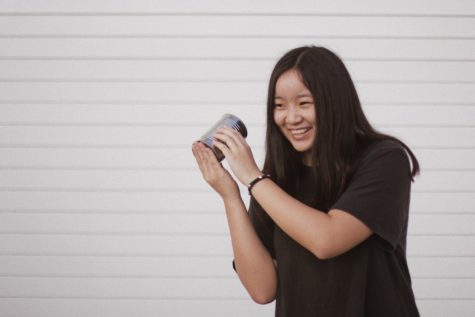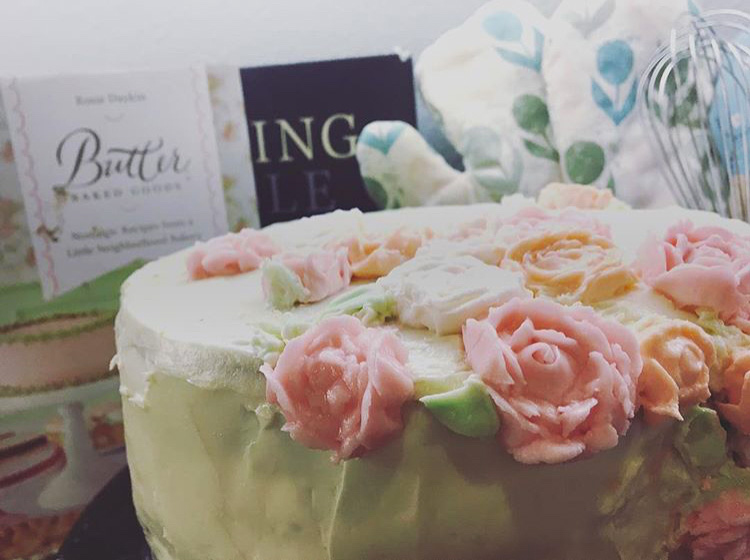Secret Menu of Food Advertisements
Photo Courtesy of Kate Hayashi
Freshman and baker Kate Hayashi posted her white buttercream cake adorned with roses for Instagram.
There is no surprise that in marketing, a pit crew of stylists and photographers ensures every crumb looks as appetizing as possible. Although the term ‘food advertiser’ resonates with food brands, students who feature food on their social media are food advertisers in the full sense.
When viewers yearn for an idealized version of food, companies count their profits because people are too hungry to care. Most consumers do not complain about presentation to the point where false advertising is an issue. According to Money US News, subconscious advertising techniques, like a carbonated soda, trigger the human brain’s craving instinct.
Instagram users use photography techniques on their social media accounts to the point where a consistent following is synonymous with profitable corporations.
“I shoot the pictures in a well-lighted area with a plain background and try my best to capture the artwork on my food,” freshman and food Instagram user Kate Hayashi said. “I do try to edit my photos before posting them to highlight the aspects of my baked goods that I am most proud of and attempt to cover up my poor photography skills.”
By targeting youth as their demographic, food advertisers attempt to connect through emotions. Having a shared passion for food production increases the brand’s following.
“I follow Rosanna Pansino because she makes cute desserts and treats based on other themes,” freshman Vina Dinh said. “Yes, I would eat something if it looked cute.”
As scrumptious as advertised food seems, the actual item may be unpalatable if not inedible. According to Mental Floss, corporations use household items like deodorant and steaming cotton balls to make their food look appealing. Deodorants matte shiny surfaces like fruit peels and steaming cotton from behind gives the illusion of fresh-from-the-oven foods.
Even for student Instagram users, food does not always taste as well as it looks.
“I posted vanilla cupcakes that I had decorated with buttercream, and the cupcakes were a touch overbaked, so they were dry. In the picture, you can’t tell that there is anything wrong with them, but they definitely did not taste like what they looked like,” Hayashi said. “I knew nobody would eat them, but I didn’t want them to go to waste so I made them look pretty and put it up on Instagram.”
In the digital age, more convincing photos of flavorless foods mislead consumers, changing their standards neurologically. These marketing secrets seep into the Instagram accounts of student food photographers. While food remains a common focus during the holidays, be aware of that there may be more to that tempting photo than its face visual presents.
Deodorants and steaming cotton products only scratch the surface of that painted plastic passed as delicious food. Corporations would involve colors and manual designs in their commercials.
According to the Huffington Post, colors with distinct emotions attached are a uniting factor among food brand, with the most prevalent color red associated with boldness and tantalizing. Warm-toned colors are reminiscent of friendliness and cheerful interaction, implying that the nearest food place is as inviting as spending time with friends. Depending on the food item, cool-toned colors reflect cold foods like a heaping scoop of ice cream, along with feelings of calmness.
For instance, in Hayashi’s photo of pink roses and mint-colored leaves in contrast with a plain white cake base, her photo implies dainty, meticulous work into piping such a design. The basic, yet endearing design provokes interest into what the cake would taste like.
Though colors and inedible objects in the food item are intriguing, the way to spark conversation about a particular food brand or student’s Instagram is to spread positive reviews about the appearance first. With this in mind, a food that looks as appetizing on camera as it is on the plate is unlikely if not already impossible without digital manipulation.
Your donation will support the student journalists of Portola High School. Your contribution will allow us to purchase equipment and cover our annual website hosting costs.

Jane Zou is a staff writer and resident cartoonist for the Portola Pilot. As one of the few sophomores in the production, Jane is excited to contribute...




